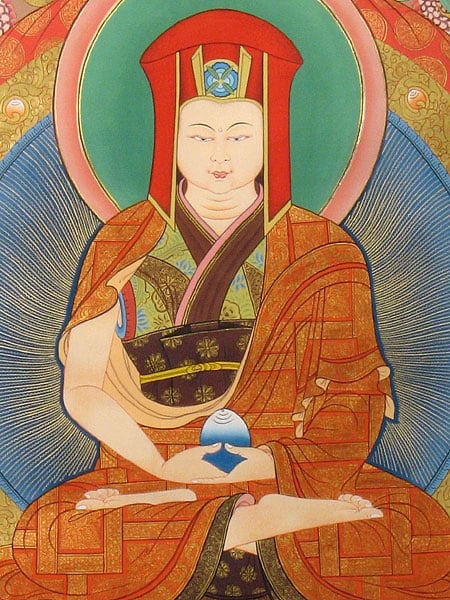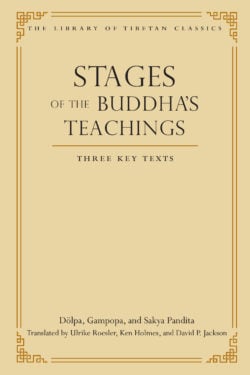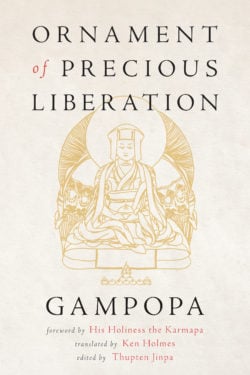Gampopa

“Gampopa, who was also known as Dakpo Rinpoché, was born in 1079 in Dakpo district of central Tibet. He originally trained to be a physician; hence the other common title he is known by, Dakpo Lhajé (“Doctor of Dakpo”). He began his adult life as a married layman and only began intensive religious practice after experiencing the shock of his beloved wife’s sudden death when he was still in his early twenties (ca. 1100). He eventually became one of the foremost disciples of the venerable Milarepa (1040–1123), but only after extensive studies in other traditions. Before meeting Milarepa, he had received full monastic ordination at the age of twenty-five (1104) and had sought out tantric initiations in Lower Dakpo from the master Maryul Loden. He had also studied intensively in Phenyul under masters of the Kadam tradition such as Jayulpa, Nyukrumpa, and Chakri Gongkhawa. Jayulpa (or Jayulwa) Shönu Ö (1075–1138) was a student of Chengawa (one of the above-mentioned “three spiritual brothers,” along with Potowa, who were Dromtönpa’s principal students), and Nyukrumpa was in the lineage of Geshé Naljorpa Chenpo (1015–78). Gampopa sought out Milarepa only later, finally receiving the key instructions from him (especially on “inner heat,” gtum mo) for thirteen months in 1110–11. After meditating for an additional three years, he attained awakening. He tried to return to see his master Milarepa twelve years later (1123), but the master had already passed away. He continued a primarily contemplative life for some years but then began his career as spiritual teacher, which became more and more illustrious with each passing year. Gampopa established the first Kagyü monastery, Daklha Gampo, which attracted a multitude of disciples during his lifetime. It is not for nothing that virtually the entire Kagyü lineage in Tibet calls itself the Dakpo Kagyü (literally, “teaching lineage of Dakpo”) in his honor. Through him, a discrete lineage composed of a series of secret tantric traditions from India, and limited to a handful of advanced followers, became integrated with the main elements of basic and Mahayana Buddhism, forming the broad and accessible basis of the Kagyü teaching tradition as it is today. This broad-spectrum Buddhism was then nurtured by his four main disciples, and in particular by the Karmapa lineage of reincarnations.”
—from Stages of the Buddha’s Teachings
Books, Courses & Podcasts
Stages of the Buddha’s Teachings
Runner-up for 2017 Shantarakshita Award for Excellence in Translation from the Tsadra Foundation
The “stages of the teachings” or tenrim genre of Tibetan spiritual writing expounds the Mahayana Buddhist teachings as a systematic progression, from the practices required at the start of the bodhisattva’s career to the final perfect awakening of buddhahood. The texts in the present volume each exerted seminal influence in the Tibetan Buddhist tradition. The first text, The Blue Compendium, presents the instructions of the Kadam teacher Potowa (1027/31–1105) as recorded by his student Dölpa (1059–1131). This verse work is followed by Gampopa’s (1079–1153) revered Ornament of Precious Liberation, which remains the most authoritative text on the path to enlightenment within the Kagyü school with its extensive quotations from the Indian scriptures. The final selection is Clarifying the Sage’s Intent, a masterwork by the preeminent sage of the Sakya tradition, Sakya Paṇḍita (1182–1251).
Learn more about the Library of Tibetan Classics
Learn about becoming a benefactor of the Library of Tibetan Classics
Ornament of Precious Liberation
Discover the heart of the Buddha’s teachings in this new and beautiful translation of Gampopa’s classic guidebook.
Ornament of Precious Liberation is a spiritual and literary treasure of Tibetan Buddhism and of the Kagyü lineage in particular. Laying out step-by-step the path to buddhahood that is open to us all, to read Gampopa’s text is like receiving the teachings directly from the master himself.
It is a quintessential guide to enlightenment that students will return to again and again for its insights into living an awakened life.


